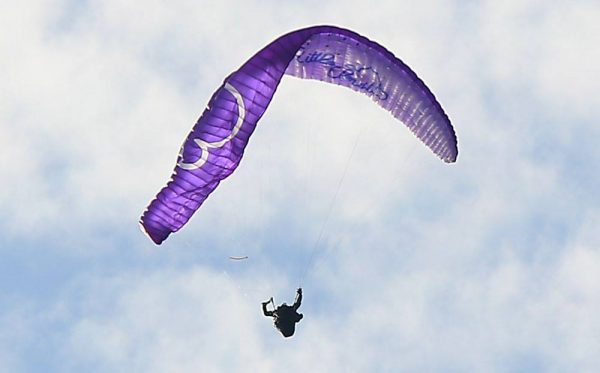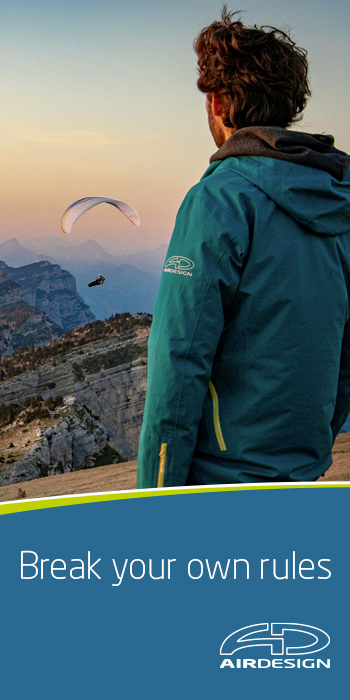
Choose your paragliding wing which matches your fly skill level
Do not follow only the wing category to choose the wing that best match your needs!!
The paraglider certification are used to sort the wing behavior and are there to ease choice according to the pilot level, in particular considering the flight incidents.
The paraglider categories (Standard DHV and CEN) have been initially created to structure the market offer and avoid dangerous wings. Beside the objectives and comparative information of the tested products, the standard is supporting preventive safety, with warning to know how easy it is for a specific wing to get out of trouble when being out of the flight domain with active or passive piloting.
The classification of the standard EN 962-2 (from A to D for the standard EN) include a scale of pilot expertise. This include for the first A category, a passive behavior of the pilot, up to an active piloting within turbulent air with use of out of flight domain techniques for the D category. In summary, the A and B wings are aimed for pilots in the learning phase when C and D categories are set for experienced pilots, who are well trained in SIV and who accept to need active piloting when being out of the flight domain.
If we want to get into more detail, the certification tests are performed by authorized structures (like the FFVL lab call Aérotest or Air Turquoise in Switzerland).Using pre serial wings from manufacturer, la large panel of test will be conducted. A first part will be focus on resistance (standard EN 926-1: see dynamic load test) and a second one related to the wing behavior during precise maneuver, most of them being done while out of flight domain (Standard EN 962-2: see framed text on the right and as well see test plan). One or several maneuver can alter it, this leading it to enter the upper category.
Race for performance within the same category
Knowing the conventional pilot criteria using categories, The manufacturer are today able, as early as in the design, to breakdown their portfolio by adjusting parameters such as aspect ratio, the canopy shape, the profile, the lines,….
The safety level of the wings have extremely increase in the last years, the manufacturer are under new pressure: many pilots wants high performance wings in categories matching their skill level. Such pressure lead manufacturer to design ultra-performant product very close to the category boundary (see framed text from Jerome Canaud on the right). We therefore witness a technology and competitive race between manufacturers in the development of wings able to manage a new ratio type: Performance against Category.
The norm EN 926
The test are done at both up and lower part of the category range. The test pilot initiate incidents and will evaluate the behavior of the wing to get out of the out of flight domain situations. The behavior of the wing will be measured according to a precise ranking from A to D. The overall result for the wing rating will use the most disadvantageous rating from all maneuvers done during the certifications test. In the end the pilot who will read the test report will know about the warning of the tested wing and the required skill level.
Description of paraglider categories according to standard
| Catégory | Description of the flight characteristics | Description of the piloting skills |
| A | Paraglider with maximal passive safety and tolerant flight characteristics. | For all pilots including pilots in training phase |
| B | Paraglider with good passive safety and tolerant flight characteristics. Medium resistance to exit normal flight domain. | For all pilots including pilots in training phase |
| C | Paraglider with moderate passive safety and potential sharp reaction to turbulence and steering mistakes. Return to normal flight might require specific steering. Medium resistance to exit normal flight domain. | For pilots experienced in techniques to exit flight domain, to active piloting, who fly regularly, and understand all consequence of a paraglider with limited passive safety. |
| D | Paraglider with demanding flight characteristics, with potential violent reactions to turbulence and steering mistake. Return to normal flight require precise steering. |
For pilots with extensive training to exit normal flight domain, to very active piloting, with high expertise in turbulent condition flights, who understand and accept all consequences of such paraglider |
Source FFVL
Attention, behind a EN B wing a wrong C can be hidden in certain conditions!
Indeed, if wings pass positively the certification test targeted by the manufacturer, some models leaning toward Perf require sometime a mind set and an active piloting corresponding to wings of the upper category. This new trend appears in the B and C categories but seems to be generalized in the B category. Indeed it is often that today to find brands proposing 2 or even 3 models in this category.
Even if these wings comply with the B category requirement list, you can expect that some will require a much higher pilot skill in turbulent air and also in incident situation to avoid any over steering risks.
As explained by Jerome Canaud: as soon as you have a standard, it is obvious that you start looking for his boundaries. I do not find this abnormal that the manufacturer propose 2 EN B in their books. It is somehow responsible. If there was only one model, the risk would be the performance race within the category. Here there is 2 models, 2 behavior, so it is easier to choose!
The new worry about the professional and test magazine: warning for pilots who are looking for a wing « upper end of the category»
During test of up end category wings (often B+ or C+), we see more and more warnings given by tests pilots who want to stay as objective as possible. We have also become aware of such new problem with the test pilots of ROCK THE OUTDOOR. Paragliding School responsible who meet quite often pilots on their sites, they witness too often that people are flying with gears much above their skill level.
You just have to read the small ads for paraglider to realize how many wings have scared their owners due to their piloting requirement (too dynamic or demanding).
For these wings with “surprising performances” in their category, the tester who stayed as objective as possible, cannot avoid during the writing of the test report to do warning who are misunderstood as negative, sometime disturbing the manufacturer, even if the overall test feedback stays positive on the wing. For these high ends category wings, there is a serious dilemma because the category classification is not anymore a sole choice criteria except if the buyer takes time to review the certification test report and integrate his own pilot skill level.
It is therefore mandatory to make pilots aware and teach them of their way to choose a wing based on real expertise (meaning doing an objective self-assessment of piloting skills), on their environment (flight routine, topography of their main flying location ….) and their target for progression.
Main maneuver during certification test
1 Inflation/takeoff
2 landing
3 Speed in straight flight
4 Control movement
5 Pitch stability exiting accelerated flight
6 Pitch stability operating control during accelerated flight
7 Roll stability and damping
8 Stability in gentle spiral
9 Behavior in a steeply banked turn
10 Symmetric front collapse (hands up and with speed bar)
11 Exiting deep stall (parachutal stall)
12 High angle of attack recovery
13 Recovery from a developed full stall
14 Asymmetric collapse (45 and 75%, hands up and accelerated flight)
15 Directional control with a maintained asymmetric collapse
16 Trim speed spin tendency (hands up)
17 Low speed spin tendency
18 Recovery from a developed spin
19 B-line stall
20 Big ears
21 Big ears in accelerated flight
22 Behavior exiting a steep spiral
23 Alternative means of directional control
Source FFVL
So how to choose? And staying honest with myself and asking myself the right questions
We could summarize this document in one sentence from Christophe Waller from “K2 Parapente”: The incidents comes from over steering. Then the right question is: does this wing match my skill level? (Read the post: EN standard, user guide). Every pilot, whatever his level, is able to try and choose a new wing assuming that he is capable to assess his abilities and ask himself the right questions on what he plan to do with it and to well review the certification test report results.
Jérôme Canaud state that the reseller has a great deal of responsibility in this process. He should know the pilot to propose him the right wing considering subjective criteria which are always the same (how many hours per year, which flight types, in which location, mind set level). It looks simple but it turn to be much more complex because the pilot’s ego and the low pricing race is taking place. The pilot is not always honest with his practice. Marketing is here selling easiness and performance without knowing the pilot. Therefore the re seller end up with a great deal of responsibility. It is wise that the seller knows and fly with the wing to adapt his advice to the customer.
As conclusion and to not finish without answer, I invite you to discover the point of view of Nicolas Garcin hereunder and the advices from Jerome Canaud on the methodology to choose a wing: How to choose a new paraglider?

Point of view of Nicolas Garcin, ROCK THE OUTDOOR tester
Be well aware of your capacities, of your level, of you type of practice and of your main flight location when you want to choose a wing.
Nicolas, as responsible of a paragliding school and as tester for ROCK THE OUTDOOR, can you please tell us why the EN category is not enough sufficient to choose a wing?
True, the categories are not sufficient anymore. Actually there is no doubt that we witness the creation of several under wings categories within the same category. The EN B and EN C being the most affected.
Within the intermediate wing segment, mainly the EN B, we witness that each manufacturer is involve in a race to balance the best compromise between performance, stability and keeping this given certification category assuming wing with a passive safety and with large tolerance to exit out of flight domain.
We see development of 2 unofficial categories for these EN B wings: B and B+ (or B sport, B high level). This means for us pilots, a difference of behavior, and as well a need to adapt to each one level. To make it short there are solid B wings and other B wings which are very close to C.
Cela signifie pour nous, pilotes, une différence de comportement, et à fortiori une adaptation différente aux niveaux de chacun. En clair, il y a les bonnes B solides et les B proches des C.
In fact I feel that I go back in time for some years where the Certification were not existing… We were having almost everything and for all expectations … but gratefully now there is no more dangerous wings.
Nowadays it is necessary to well assess his piloting level before choosing a wing within a given category.
Yes, you better know your level before choosing a wing. Indeed some will forgive better than others within the same category. A paraglider stay a paraglider and some actual wings do not or less tolerate the over piloting. This may lead to incident chain. Even a “quite C” as we can hear sometime, stay an EN C. In the B, it is the same. Be always aware of your paragliding capacities, of your level, of your ambitions and of the flying location topology.
So, how to do the right choice? How to know if his piloting level is matching?
Pro are here for that! Living in the south of the Alps, it is true that we see a lot of pilots who unfortunately fly with wing that do not fit their level… The test done by test pilots will allow you to know the wing characteristics available on the market but still it is necessary to know how to assess his piloting level. If you have doubt, do not hesitate to ask for help from a Pro who know well the gears he propose you and who knows you.
Some says that to progress, you have to accept to move the cursor “dangerous zone”. And if a pilot is attracted by a wing which is a bit more demanding looking for progress, what advice would you give him?
Whatever your level, if you splurge for a wing a bit above to progress, I would recommend that you do not change during the winter season, in order to progressively get used to it, to do a lot of ground handling, and to include 1 or 2 days of SIV to get rid of most fear and to continue enjoying your sport!!
Nicolas Garcin – Paragliding School FULL BLUE SKY
Translation Daniel Gras


